Summer Starts on Sunday, the Bright Moon Jumps the Scorpion and Spoils the Milk, Shadows Speed across Jupiter and Mars Bugs the Bees!
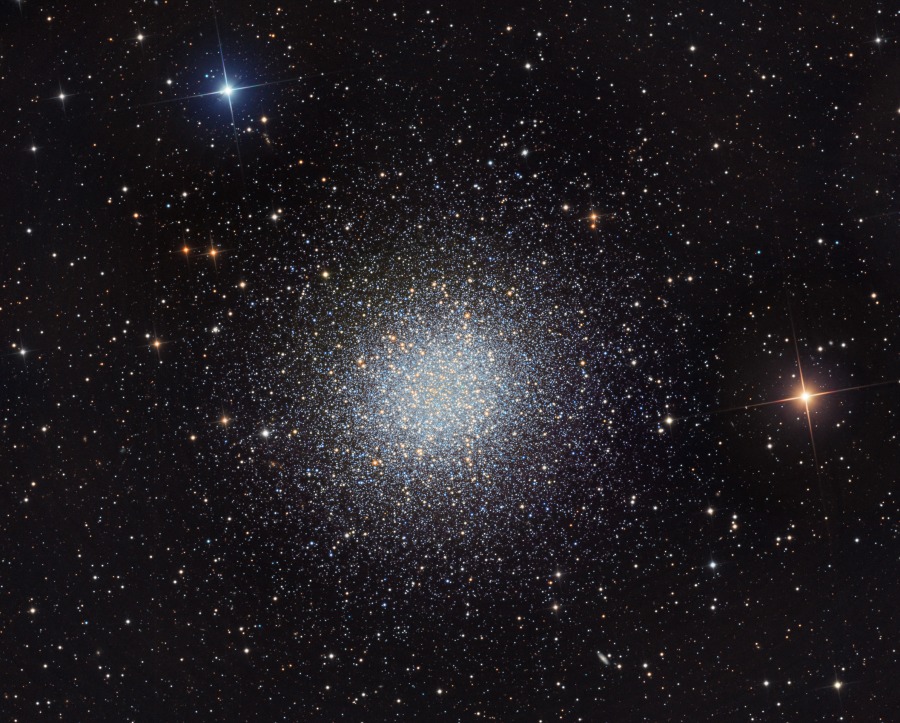
This image of Messier 13 in Hercules, the father of all globular star clusters visible from the Northern Hemisphere, was captured by Martin Pugh. Hundreds of thousands of stars, 25,000 light-years away from the sun, are arranged in a sphere by their mutual gravitational attraction. M13 is visible as a faint fuzzy patch to the unaided eyes on a moonless night, and through binoculars and backyard telescopes, even from the city. NASA APOD for June 14, 2012
Happy Father’s Day, Stargazers!
Here are your Astronomy Skylights for the week of June 20th, 2021 by Chris Vaughan. Feel free to pass this along to your friends and send me your comments, questions, and suggested topics. You can also follow me on Twitter as @astrogeoguy! Unless otherwise noted, all times are expressed in Eastern Time. To subscribe to these emails please click this MailChimp link.
I can bring my Digital Starlab portable inflatable planetarium to your school or other daytime or evening event, or teach a session online. Contact me through AstroGeo.ca, and we’ll tour the Universe, or the Earth’s interior, together!
The summer season gets underway for the Northern Hemisphere. This week, the moon will be shining brightly in the night-time sky all around the world – so I’ll highlight some features on it, especially during full moon period on Wednesday-Thursday. In the western sky after sunset dim Mars and brilliant Venus will begin to draw closer together! The gas giant planets will rise at about midnight and then remain visible until dawn – and two moon shadows will literally race across Jupiter on Saturday morning. Read on for your Skylights!
The June Solstice starts the Northern Summer
The beginning of summer for the Northern Hemisphere, known as the June Solstice or Summer Solstice, occurs on Sunday, June 20 at 11:32 pm Eastern Daylight Time (or 03:32 Greenwich Mean Time on Monday, June 21). At that moment, the northern end of Earth’s axis of rotation will be tipped by 23.5° towards the sun. As a result, the sun will climb to its highest mid-day position in our sky for the year, sunlight will shine more intensely on the Northern Hemisphere, and northerners will receive the longest amount of daylight.
More hours of concentrated sunlight translates to more solar energy and warmer days! It is NOT the case, as some people think, that we are warmer in summertime because we are closer to the Sun. That scenario, called perihelion, actually happens in early January every year! As a matter of fact, the Earth is now only two weeks away from reaching its greatest distance from the sun, or aphelion, for this year. That will occur on July 5.
For our friends in the Southern Hemisphere, this solstice signals the sun’s lowest noon-time height for the year, and marks the start of their winter. The June solstice is eagerly awaited by Northern Hemisphere astronomers because, after Sunday, the days will slowly start to get shorter while their nights lengthen.

The Moon (and Some Scorpius / Libra History)
This week, the bright moon will continue to light up the evening sky around the world – but after passing its full phase on Thursday night, our natural night-light won’t really become visible above the treetops until after midnight during the coming weekend.
Today (Sunday) the waxing gibbous moon will shine between the modest stars of Virgo (the Maiden) on the right (celestial west) and Libra (the Scales) on the left. You can see the moon’s pale orb in a daytime sky after it rises in late afternoon. As night falls, look for the Golden Handle effect, produced when the terminator falls to the left (or lunar west) of Sinus Iridum, the Bay of Rainbows. Slanted sunlight brightens the eastern (right-hand) side of the prominent, curved Montes Jura, the mountain range that surrounds the bay on the top and left (north and west). You can see the feature with sharp eyes – and easily in binoculars and backyard telescopes – even before the sun sets.
After spending Monday in Libra, on Tuesday night the nearly full moon will slide east and dance on the head of Scorpius (the Scorpion). The three stars that form the claws of the predatory arachnid are magnitude 2.6 Acrab or Graffias (the names arise from Arabic expressions for “scorpion” and “claws”, respectively) at the top, somewhat brighter Dscubba (Arabic for the “forehead”) in the middle, and the faintest of the trio Pi Scorpii (or π Sco) at the bottom.
Those stars won’t be very apparent since they’ll be shining only a palm’s width to the right (or 6 ° to the celestial west) of such a bright moon. But the heart of the scorpion, the very bright reddish star Antares will sit just a few finger widths below the moon, and will be easy to see. Dscubba’s name is an echo of the past, when Libra’s two brightest stars Zuben Eschamali “the Northern Claw” and Zuben Elgenubi “the Southern Claw”, were counted as the actual tips of Scorpius’ much longer pincers. Libra’s third brightest star, Sigma Librae, is located below (south of) those two stars. Nowadays it completes the scale’s mechanism. In 1930, the International Astronomical Union (IAU) removed the star from Scorpius and assigned it to Libra. So the former Gamma Scorpii or Zuben Elgenubi I has a new identity. It’s often labelled using the common names Brachium “arm” or Cornu “horn”.
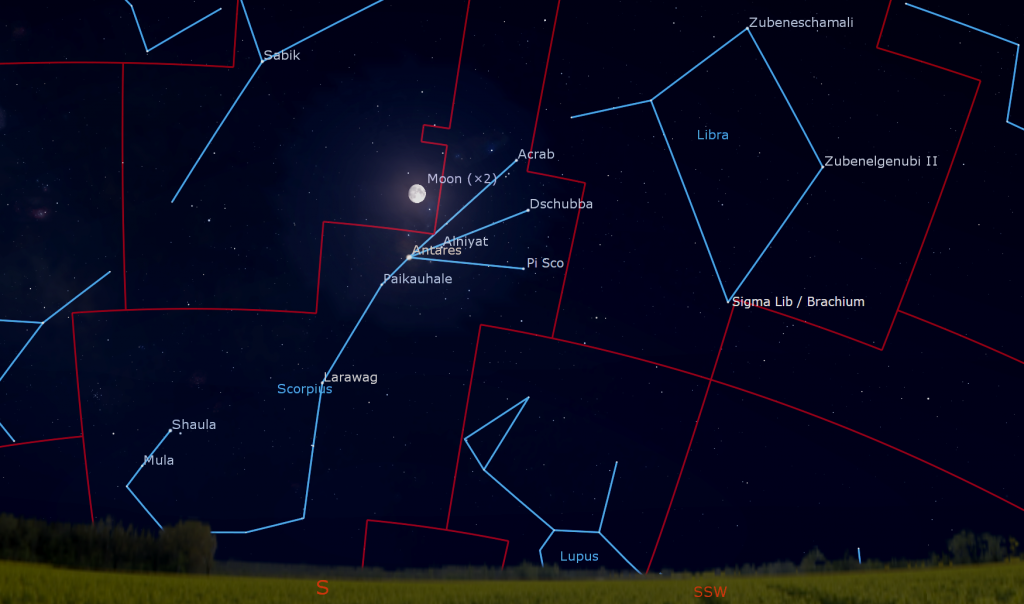
On Wednesday night the moon will shine near the eastern toe stars of Ophiuchus (the Serpent-Bearer) and will overwhelm the nearby summer Milky Way. With the moon only hours away from full, it will look fully illuminated on Wednesday night – with only a thin arc of shadowed craters along its western (right-hand edge). When the moon sets in the west just before sunrise on Thursday morning, it will be 99.6% illuminated.
The moon will officially reach its full phase, opposite from the sun, at 2:39 pm EDT (or 11:39 am PDT and 18:39 GMT) on Thursday, June 24. The June full moon always shines in or near the stars of southern Ophiuchus or next-door Sagittarius (the Archer).
Every culture around the world has developed its own stories about the full moon, and has assigned special names to each one. The indigenous Ojibwe people of the Great Lakes region call this moon Ode’miin Giizis, the Strawberry Moon. For the Cree Nation it’s Opiniyawiwipisim, the Egg Laying Moon (referring to the activities of wild water-fowl). The Mohawks call it Ohiarí:Ha, the Fruits are Small Moon. The Cherokee call it Tihaluhiyi, the “the Green Corn Moon”, when crops are growing. English-speaking, non-indigenous groups commonly use Strawberry Moon, Mead Moon, Rose Moon, or Hot Moon.
When the moon rises many hours later in North America, that thin strip of shadowed craters will have switched to the moon’s eastern (or left-hand) edge. Try viewing the moon in binoculars or a telescope on both nights and note the change! Moon phases occur independently of Earth’s rotation. So while the Americas will not see the moon while it’s precisely full, observers across central Europe and Africa and all of Asia will!
When you face a full moon, the sunlight shining on it is coming from directly behind you – the same way the projector in the rear of a cinema lights up the movie screen in front of you. That sunlight is arriving straight-on to the moon’s surface, so it doesn’t generate any shadows. Every variation in brightness and colour you see on the full moon is due entirely to the moon’s geology, not its topography! Now you can easily distinguish the dark, grey basalt rocks from the bright, white, aluminum-rich anorthosite rocks.
The basalts overlay the various lunar maria, Latin for “seas” – coined because people used to think they were water-filled. The maria are basins excavated by major impactors early in the moon’s geologic history and then later infilled with dark basaltic rock that upwelled from the interior of the moon late in the moon’s geological history.
The much older and brighter parts of the moon are composed of anorthosite rock. Those areas are higher in elevation and are heavily cratered because there is no wind and water, or plate tectonics, to erase the scars of impacts. By the way, the bright, white appearance is produced by sunlight reflecting off of the crystals the rock is made of – the same sort of crystals you see in the granite countertops in Earth’s kitchens. And yes, there are coloured rocks on the moon.
Some of the violent impacts that created the craters in the highland regions also threw bright streams of ejected material far outward and onto the darker maria. We call those streaks lunar ray systems. Some rays are thousands of km in length – like the ones emanating from the very bright crater Tycho in the moon’s southern central region.
Use your binoculars to scan around the full moon. There are smaller ray systems everywhere! There are also places where craters punched into the maria have ejected dark rays on to white rocks. And, since the dark basalt overlays the white, older rock below, you can find lots of craters where a hole has been punched through the dark rock, producing a white-bottomed crater!
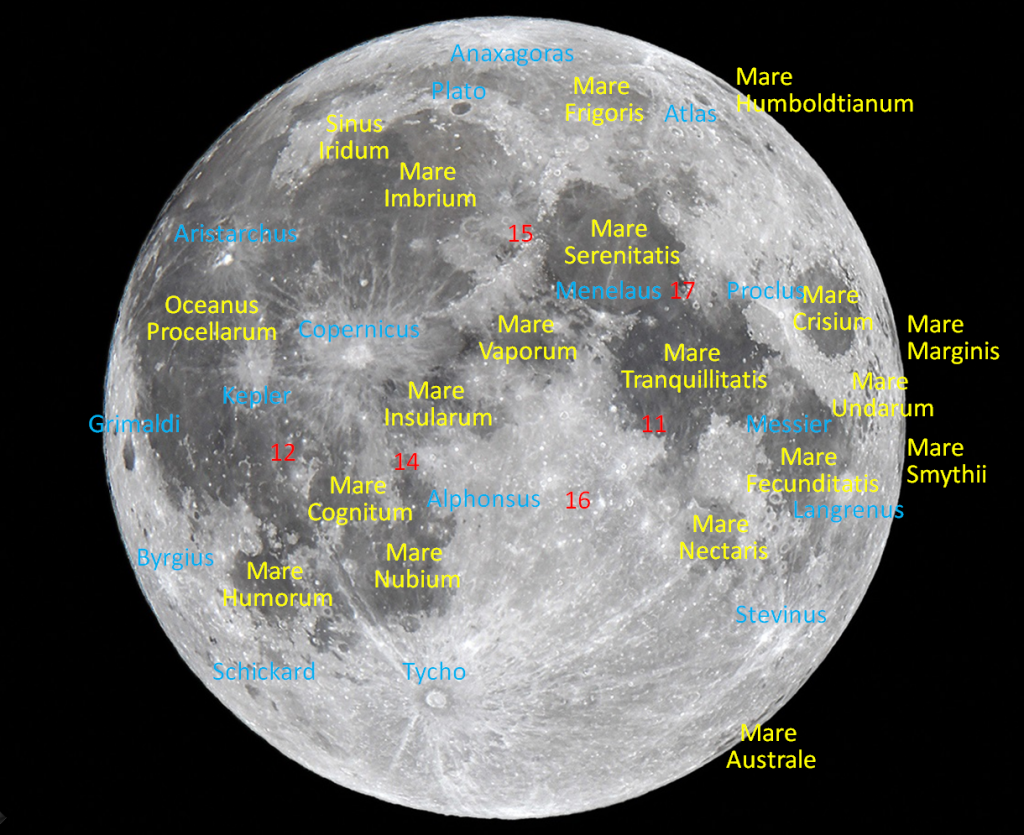
Several of the maria link together to form a curving chain across the northern half of the moon’s near-side. Mare Tranquillitatis, where humanity first walked upon the moon, is the large, round mare in the centre of the chain. You can plainly see that this mare is darker and bluer than the others, due to its basalt being enrichment in the mineral titanium. That’s one of the reasons why Apollo 11 was sent to that location.
By the way, Earth-bound telescopes – even the largest ones – cannot see the items left by the astronauts on the moon. When the air is particularly steady, the smallest feature you can see on the moon with your backyard telescope is about 2 to 6 km across – far larger than a lunar module descent stage. Only the cameras on spacecraft in orbit around the moon can photograph astronauts’ footprints, lunar rover tracks, and equipment.
The moon will spend Thursday night inside the stars of Sagittarius’ Teapot asterism, and Friday night off to left of those stars. On Saturday, the moon will rise shortly before midnight, and it will sit a palm’s width to the lower right (or 6° to the celestial southwest) of the bright yellow dot of Saturn – with brighter Jupiter off to their left. This photo opportunity will be even better after midnight on Sunday night (i.e., early Monday morning), when the waning gibbous moon will be parked below and between those two bright planets!
The Planets
Extremely bright Venus will pop out of the darkening sky, a little to the left of where the sun went down, at about 9:45 pm local time. If you have an unobstructed view toward the west-northwest, you can see the planet’s brilliant speck of light sitting quite low in the sky until it sets, at about 10:45 pm local time. That time barely changes night after night because Venus’ eastward orbital motion is opposite to the westward motion of the sky produced by Earth’s orbit of the sun.

Venus’ position 24° east of the sun and on the far side of the sun from Earth will make the planet look smaller than average and only 90% illuminated – producing a squashed shape in your telescope. Use your telescope on Venus as soon as you can spot the planet. That way, it will be higher, and shining through less distorting atmosphere. Ensure that the sun has completely disappeared first!
Meanwhile, Mars is being carried sunward and a bit lower every night because of our orbital motion. That means that Venus and Mars are two “trains” heading towards one another on the same “track”, the ecliptic. Their dance in the western post-sunset sky will climax when they kiss in a close conjunction next month. Those motions offer a terrific opportunity to observe the workings of our solar system.
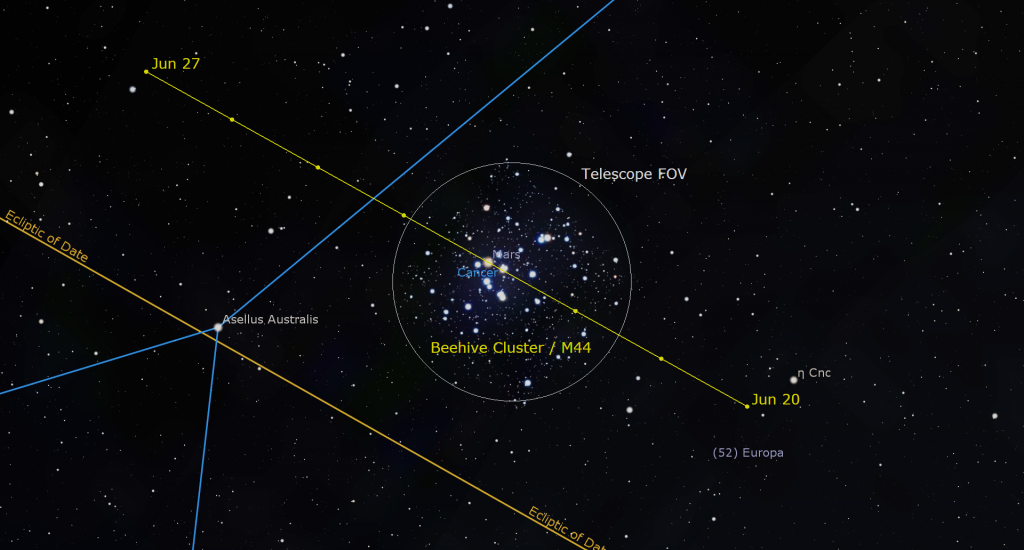
The sky will need to get darker before the faint reddish dot of Mars appears. Look for it about 1.3 fist diameters to the upper left of Venus. Mars will set in the west after about 11 pm local time. On Wednesday evening, Mars’ eastward orbital motion will carry it directly through the large open star cluster known as the Beehive or Messier 44 in Cancer (the Crab). The passage will be a terrific sight in a backyard telescope – although binoculars will show the cluster’s stars, too. Mars will be telescope-close to the “bees” on the surrounding evenings. The event will be better for observers at southerly latitudes where the cluster will be higher when the sky darkens.
This week yellow-tinted, magnitude 0.43 Saturn will rise within the stars of central Capricornus (the Sea-Goat) by about 11 pm local time. A few weeks ago Saturn began a retrograde loop that will last until mid-October. You can observe the planet’s westerly motion by noting how its distance from the medium-bright star to its left (east) named Theta Capricorni increases each night. If you get up early, or stay up late, to see them, watch for the Milky Way and the teapot-shaped stars of Sagittarius (the Archer) sitting several fist diameters off to their right (celestial west).
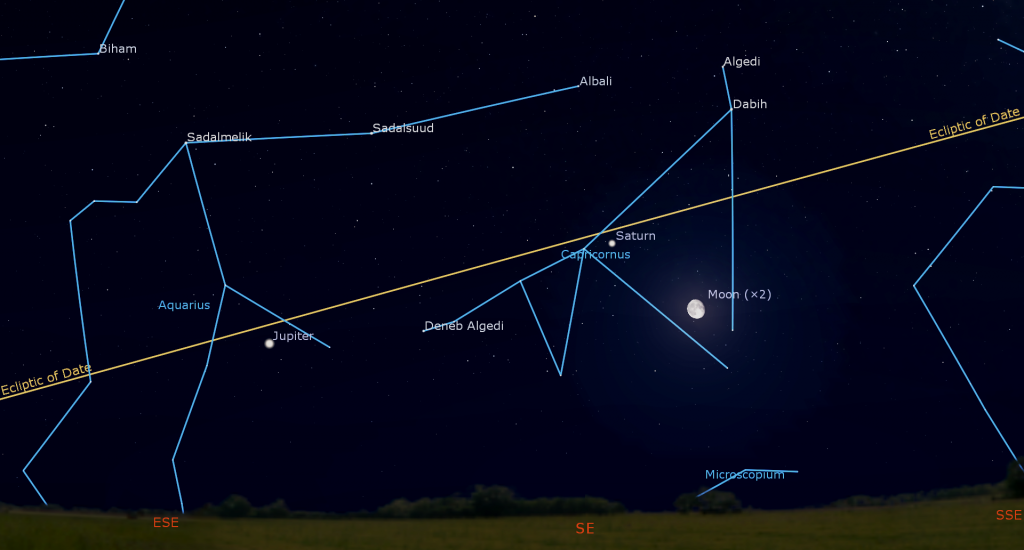
Even a small telescope will show Saturn’s rings and several of its brighter moons – especially its largest moon, Titan! Because Saturn’s axis of rotation is tipped about 27° from vertical (a bit more than Earth’s axis), we can see the top surface of its rings, and its moons can arrange themselves above, below, or to either side of the planet. During this week, Titan will migrate counter-clockwise around Saturn, moving from the lower left (celestial east) of Saturn on Sunday night to the upper right (west) of the planet next Sunday. (Remember that your telescope will flip the view around.)
Jupiter will begin to rise before midnight this week, and then remain visible until almost sunrise! The bright, white, magnitude -2.6 planet is positioned among the stars of central Aquarius (the Water-Bearer) – about two fist diameters to Saturn’s lower left (or 19° to the celestial east). On Monday, Jupiter will pause in its regular eastward motion in front of the distant stars of western Aquarius and then it will begin a retrograde loop that will last until mid-October. The apparent reversal in Jupiter’s motion is an effect of parallax produced when Earth, on a faster orbit, begins to pass Jupiter on the “inside track”.
The Great Red Spot (or GRS) will be visible crossing Jupiter on Tuesday, Friday, and Sunday morning. From time to time, the small round black shadows cast by Jupiter’s four Galilean moons become visible in amateur telescopes when they cross (or transit) the planet’s disk. During the wee hours of Saturday, June 26, observers in the eastern half of North America and all of Central and South America can use amateur telescopes to watch two shadows cross the planet’s disk together! At 1:04 am EDT (or 5:04 GMT) Io’s smaller, faster-moving shadow will join Callisto’s larger shadow already in transit. Io’s shadow will catch up and pass a short distance north of Callisto’s shadow at 2:25 am EDT (or 6:25 GMT) – and then it will lead the way across Jupiter until 3:22 am EDT (or 7:22 GMT). Callisto’s slower shadow will complete its crossing at 4:21 am EDT.

Dim, blue Neptune is following Jupiter across the sky. It rises at about 1 am local time, and sits about 2 fist diameters to the left of Jupiter – on the border between Aquarius and Pisces (the Fishes). On Saturday, June 26, Neptune will begin its own retrograde loop that will last until early December. Later this month, medium-bright Uranus will have swung wide enough of the pre-dawn sun to become visible below the bright stars in Aries (the Ram). Mercury will join the pre-dawn parade next week.
Public Astro-Themed Events
Every Monday evening, York University’s Allan I. Carswell Observatory runs an online star party – broadcasting views from four telescopes/cameras, answering viewer questions, and taking requests! Details are here. Their in-person Wednesday night viewing has been converted to online via the observatory YouTube channel, where they offer free online viewing through their rooftop telescopes, including their 1-metre telescope! Details are here.
Don’t forget to take advantage of the astronomy-themed YouTube videos posted by RASC Toronto Centre and RASC Canada.
My free, family-friendly Insider’s Guide to the Galaxy webcasts with Jenna Hinds of RASC National will return in July with a Summer Planets Spectacular! You can find more details, and the schedule of future sessions, here and here.
Space Station Flyovers
The ISS (or International Space Station) will resume flyovers for the GTA next week.
Keep looking up, and enjoy the sky when you do. I love questions and requests. Send me some!